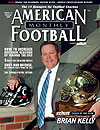Article CategoriesAFM Magazine
|
Middle Cross Kickoff Returnby: Abe MikellDefensive Line Coach/Special Teams Coordinator Stuarts Draft High School (VA) © More from this issue Developing and repping a solid kickoff return team can be an explosive offensive weapon for your football team. With the kickoff team, you are generally looking to avoid negative momentum. However, with the kickoff return team, you can gain a huge momentum swing with a great return. At the very least, you want to give your offense the ball outside of the 30-yard line. The kickoff return team is important, because you can give your offense the ball in good field position, and could possibly even score a TD. Why do we do what we do?
|
|
|||||||
| HOME |
MAGAZINE |
SUBSCRIBE | ONLINE COLUMNISTS | COACHING VIDEOS |
Copyright 2026, AmericanFootballMonthly.com
All Rights Reserved





